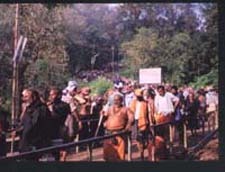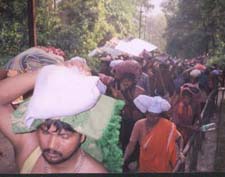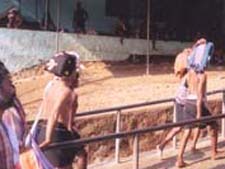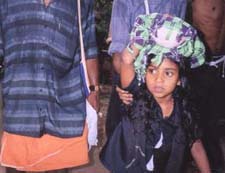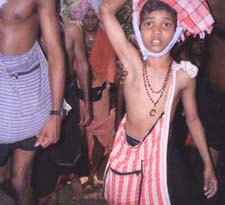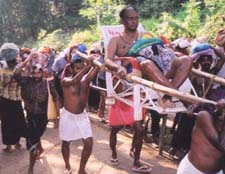| | ||
| |
|
|
|
|
The
Sabarimala temple - The trekking
Children,
the young and old people moving up the Neelimala in the Comfortable buses operated by the Kerala State Road Transport Corporation are in plenty during the season. Private vehicles and taxis also go up to Pamba river at the foothills of Sabarimala (Neelimala). For those taking the non-traditional route of Chengannoor/Tiruvalla-Pamba the distance is 95 km. From Pamba this route is south-western direction. Traditionally, pilgrims used to reach Pamba from its north-western side via Erumeli. After certain rigorous rituals at Erumeli they had to climb up and down Karimala, a very harduous hill, to reach Pamba at the foot of the Sabari hill (Neelimala) for the final leg of trekking. At Pamba both routes merge. Bus service has started from Erumeli to Pamba also recently, a distance of 60 km. To reach Erumeli, those coming from far away have to come to and turn east from Kottayam, a major transport and rail station on the state's main trunk route. (There is no railway to the east, the hilly region called Sahayadri or Western Ghats. The state being a strip running north-south, the rail lines and the trunk bus routes run from end to end). The trunk road/rail route is Kasargode-Calicut-Ernakulam-Kottayam-Tiruvalla-Chengannoor-Thiruvananthapuram. The distance from Kottayam to Erumeli in the east is 55 km. The pilgrims who takes the north-western route via Erumeli observe all the conventional rituals like 'petta thullal' at Erumeli before climbing the Karimala to reach Pamba. Pamba riverfront is the place where pilgrims from both the north-western and south-western routes gather. The divine Pamba is central to the pilgrimage as, according to the story, Lord Ayyappa as a baby was found by the Pandalam raja abandoned there on the banks. It is said the river taking its origin in the hills has medicinal qualities and that there in it grows a plant that can transform copper etc into gold. The name of the plant is 'neelakurinji'. Of course, with lakhs milling around, the waters are polluted and it is advisable for the health conscious to take a dip upstream. After taking the holy dip, the devotees begin the trekking that lasts about four hours to reach the sanctum sanctorum. An overnight trip is what most people prefer because that will be less tiring. The nights are colder in those hills in December-January but needs no woollen clothings. All facilities are available fine en route the rocky tracks up the hill, including even free cardiology clinic and oxygen parlours, a must for the unsuspecting trekkers. The pilgrims keep chanting 'Swamiye Saranamayyappa, Dharmasasthave Saranamayyappa' in praise of the Sastha deity For travel sites in Kerala click on the following links Thiruvananthapuram (Trivandrum) , Kovalm Beach, Kumarakom Backwaters, Kochi (Cochin), Periyar-Thekkady Wildlife Sanctuary, Munnar, Malabar, Bekal Fort
|
Tourist
offices
|
| |
Home
Contact Us
NOTE:
Free contributions of articles and reports may be sent to editor@indiatraveltimes.com
DISCLAIMER
All Rights Reserved ©indiatraveltimes.com

